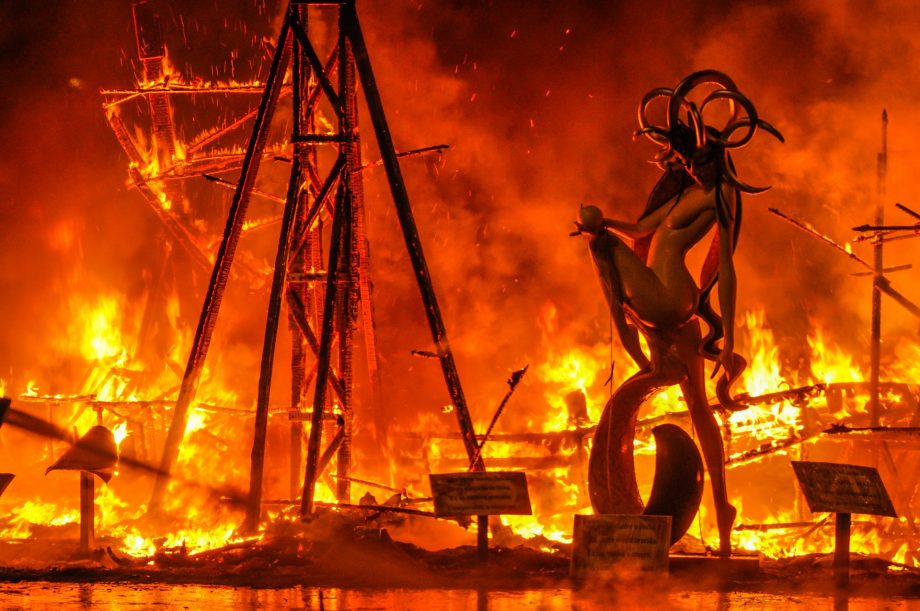The Mediterranean retreat of Valencia is one of the most beautiful cities in Spain, and indeed in all of Western Europe. The city streets become particularly glorious with the arrival of spring, and all the positivity and optimism that this change of the season heralds. Fittingly, Valencians celebrate this annual occasion with Las Fallas, the fire festival.
Las Fallas sees ninots – sizable effigies that lampoon a variety of politicians, bullfighters and celebrities, both domestic and international – carried through the streets against a backdrop of pyrotechnics and fireworks, eventually burned on a giant bonfire in the spirit of celebration. Held each and every year between the 15th and 19th of March, 2017 sees no exception to this carnival of fire.
The concept of Las Fallas dates back to the Middle Ages, started by the city’s carpenters as a tribute to their patron saint, Joseph (or San José to the native speakers). Woodworkers would need to labour by candlelight when darkness fell in these pre-electricity days, and naturally the winter months saw no shortage of long, dark nights. They would position these candles on planks of wood referred to as parots, and when spring finally arrived, the workers would burn these parots to celebrate the end of the cold and dim winter working conditions. Soon enough, clothing was added to these planks of wood in attempts at affiliating them with local figures, and different suburbs of Valencia entered into competition with one another to provide the most eye-catching fire.
The Spanish authorities eventually made Las Fallas an official event, mainly to avoid the number of fires being lit around the city growing out of control. Every neighbourhood has its own organisation committee, sharing the load of raising finance for the ninots (forget images of your childhood years spent stuffing a guy with dead leaves; these are elaborate constructions consisting of cardboard, wood, styrofoam, cork, plaster and papier-maché, in addition to being stuffed with fireworks) and the tableaux scenes, many of which reach 20 feet high and taller.
Las Fallas officially takes starts on March the 15th, but preparations really begin from the 1st. From this date onwards, gunpowder explosions will take place at 2pm each day at Plaza del Ayuntamiento (known as mascletás), which Valenicans take a signal that it is time to break for lunch. When the 15th arrives, the many organising committees take to the streets of their community and begin erecting the ninots and tableaux, as custom dictates that these effigies must be in position by the break of dawn on the 16th. A panel judges the fruits of these labours on the 17th, with prizes distributed to adults and children at Plaza del Ayuntamiento.
March the 15th, the official opening day of the festival, marks the first night of fireworks. A cascade of colours lights up the night sky for the next five nights, with Valencians gathering at Paseo de la Alameda at midnight each evening to marvel at the spectacular light show. Nit of Foc, of Night of Fire, is a unique display that takes place during the small hours of March the 18th.
You may be familiar with the concept of Ofrenda de Flores, or The Offering of Flowers. This is a Las Fallas custom that sees Valencians partaking in a parade to Plaza de la Virgin between 4pm and nightfall in order to lay bouquets before the city’s patron saint, Our Lady of the Forsaken. These flowers are used to create a 14-foot tapestry that is proudly displayed before the cathedral. General Franco introduced religious elements of the festival such as this in more recent times, as the ninos of Las Fallas struggled to maintain their critical and satirical edge during the dictator’s reign.
Of course, this just leaves La Cremà – The Burning. The pinnacle of the Las Fallas festival that takes place throughout the 19th of March, La Cremà typically begins at around 10pm with the burning of the first ninot, and continues throughout the night. Each and every structure will be scorched in celebration, and yet another spectacular firework display acts as a backdrop to these burning festivities. Tradition dictates that the final ninot is reduced to ash at around 1am in Plaza del Ayuntamiento, though each year one structure – decided upon by public vote – is spared the sacrifice of the flames. Once the embers start to calm down, spring arrives in Valencia and the hard-working organisers of Las Fallas can relax for another year.
Spain hosts a great many festivals and celebrations throughout the year, but Las Fallas is one of the biggest and brightest. People from all over the world flock to join Valencians in celebrating the arrival of spring, tripling the numbers of the population for a few days, and the festival has been awarded the status of UNESCO Intangible Cultural Heritage of Humanity. It isn’t possible for everybody to enjoy, unfortunately, due to the ear-splitting cacophony of noise involved (the Spanish authorities forbid pregnant women from attending for this very reason), but if possible, you really should consider experiencing Las Fallas at least once.


